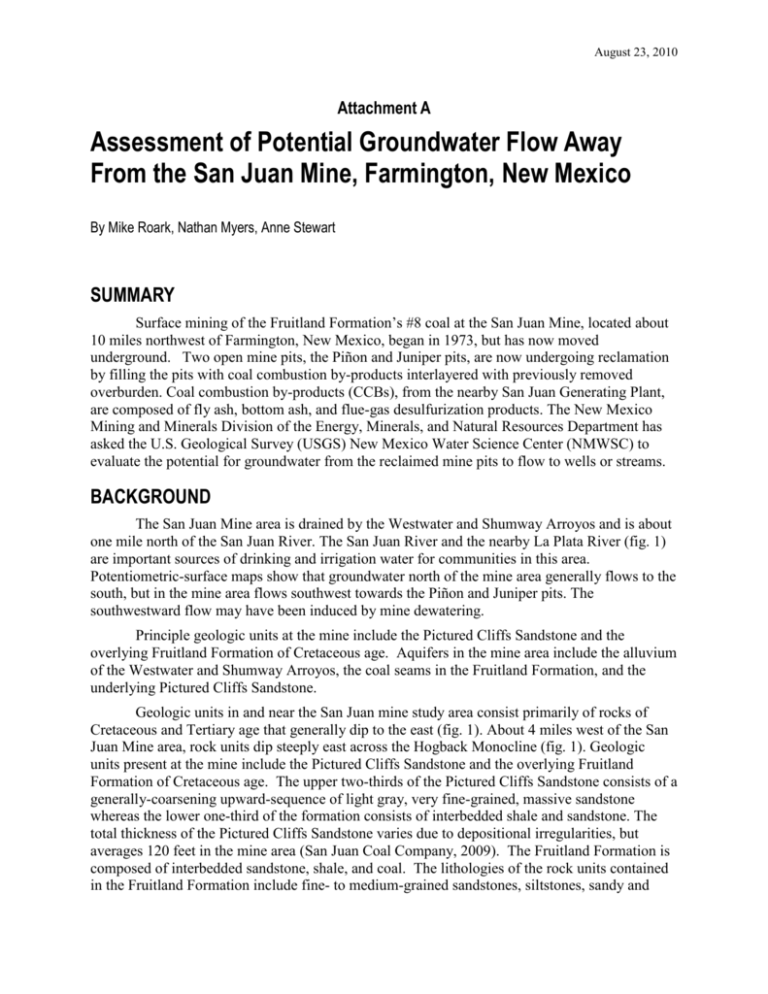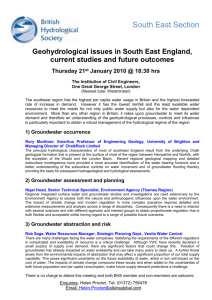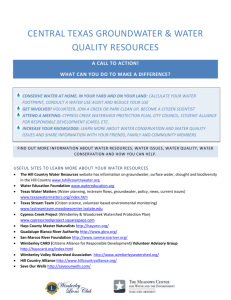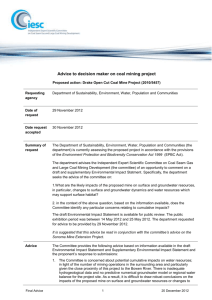word doc - University of New Mexico
advertisement

August 23, 2010 Attachment A Assessment of Potential Groundwater Flow Away From the San Juan Mine, Farmington, New Mexico By Mike Roark, Nathan Myers, Anne Stewart SUMMARY Surface mining of the Fruitland Formation’s #8 coal at the San Juan Mine, located about 10 miles northwest of Farmington, New Mexico, began in 1973, but has now moved underground. Two open mine pits, the Piñon and Juniper pits, are now undergoing reclamation by filling the pits with coal combustion by-products interlayered with previously removed overburden. Coal combustion by-products (CCBs), from the nearby San Juan Generating Plant, are composed of fly ash, bottom ash, and flue-gas desulfurization products. The New Mexico Mining and Minerals Division of the Energy, Minerals, and Natural Resources Department has asked the U.S. Geological Survey (USGS) New Mexico Water Science Center (NMWSC) to evaluate the potential for groundwater from the reclaimed mine pits to flow to wells or streams. BACKGROUND The San Juan Mine area is drained by the Westwater and Shumway Arroyos and is about one mile north of the San Juan River. The San Juan River and the nearby La Plata River (fig. 1) are important sources of drinking and irrigation water for communities in this area. Potentiometric-surface maps show that groundwater north of the mine area generally flows to the south, but in the mine area flows southwest towards the Piñon and Juniper pits. The southwestward flow may have been induced by mine dewatering. Principle geologic units at the mine include the Pictured Cliffs Sandstone and the overlying Fruitland Formation of Cretaceous age. Aquifers in the mine area include the alluvium of the Westwater and Shumway Arroyos, the coal seams in the Fruitland Formation, and the underlying Pictured Cliffs Sandstone. Geologic units in and near the San Juan mine study area consist primarily of rocks of Cretaceous and Tertiary age that generally dip to the east (fig. 1). About 4 miles west of the San Juan Mine area, rock units dip steeply east across the Hogback Monocline (fig. 1). Geologic units present at the mine include the Pictured Cliffs Sandstone and the overlying Fruitland Formation of Cretaceous age. The upper two-thirds of the Pictured Cliffs Sandstone consists of a generally-coarsening upward-sequence of light gray, very fine-grained, massive sandstone whereas the lower one-third of the formation consists of interbedded shale and sandstone. The total thickness of the Pictured Cliffs Sandstone varies due to depositional irregularities, but averages 120 feet in the mine area (San Juan Coal Company, 2009). The Fruitland Formation is composed of interbedded sandstone, shale, and coal. The lithologies of the rock units contained in the Fruitland Formation include fine- to medium-grained sandstones, siltstones, sandy and August 23, 2010 silty claystones, carbonaceous claystones, bentonitic claystones, and coal, including the #8 coal. The #8 coal is 9- to 13-feet thick in the mine area and the bottom of the #8 coal is about 11 to 20 feet above the top of the Pictured Cliffs Sandstone (San Juan Coal Company, 2009). The aquifers in the mine area include the alluvium of the Westwater and Shumway Arroyos, the coal seams in the Fruitland Formation, and the underlying Pictured Cliffs Sandstone. OBJECTIVES AND SCOPE The objective of this study is to determine potential groundwater flow paths away from the San Juan Mine that could allow metals that may be leached from CCBs in the reclaimed mine pits to reach wells or streams. The hydrologic bounds of the study area will be the San Juan River on the south, Salt Creek Wash on the west, the New Mexico-Colorado border on the north, and the La Plata River on the east (fig. 1). Hydrogeologic information available for the mine area, adjacent aquifers, and nearby streams will be used in this study. Tasks to meet the objectives of this study include: 1) compile and review existing literature and data, 2) evaluate, characterize, and compile water-quality data for the purpose of calibration of the groundwater flow model, and 3) determine potential groundwater flowpaths from the reclaimed mine pits to wells or streams. A Scientific-Investigations Reports will be written and published that describe the data collected during the study and the results of this study. Data collected by the USGS will be stored in the USGS NWIS data base and will be available through the USGS NWIS web site. The groundwater-flow model will be archived at the USGS New Mexico Water Science Center office and will be available on request. RELEVANCE AND BENEFITS The study will contribute to the USGS mission by increasing understanding of surfacewater and groundwater hydrology in the Farmington area of the San Juan Basin. Increasing the understanding of the surface-water and groundwater hydrology also will provide information for the management decisions of State agencies that manage water and mineral-resources in the Farmington area. This study will meet the USGS Science Issue of “Water Availability and Use”. The study will improve watershed characterization and flow-system definition and simulation for the management of aquifers and streams that serve as important local or regional sources of water supply. The study also will provide a quantitative understanding of the sources of groundwater flowing to wells and streams. APPROACH Task 1. – Compile and review existing literature and data Existing geologic and hydrologic literature relevant to the San Juan Mine and associated groundwater and surface-water systems will be compiled and reviewed. Literature will include published reports, journal articles, and any available consultant reports. Geologic, hydrologic, and water-quality data will be compiled from USGS, Bureau of Land Management, MMD, New Mexico Environment Department, and San Juan Coal Company databases. Compilation and August 23, 2010 review of literature and data will be used to identify data gaps and to guide the acquisition or collection of additional data during this study. Task 2 – Water-Quality Data Evaluation Existing groundwater and surface-water quality data will be evaluated, characterized, and compiled to use for calibration of the groundwater flow digital model. Task 3 – Determine potential groundwater flowpaths from the reclaimed mine pits to wells or streams This task has multiple components including, field support of University of New Mexico data-collection efforts, estimates of groundwater flow (levels, direction, gradient, volume) into and out of the mine area, estimates of groundwater recharge from precipitation and from surfacewater infiltration, estimates of hydraulic properties of water-bearing units, development of a conceptual hydrogeologic model of the San Juan Mine area, and development of a digital groundwater-flow model. Support of Field Data Collection The field data collection effort will be supported by the USGS with cooperative water program funds, for the following tasks: a) In-situ CCB sample collection with the USGS Geoprobe from location(s) in the Piñon and/or Juniper pits. This task includes mobilization and demobilitation of the Geoprobe, and use of the Geoprobe , required materials and time of support staff; b) Purchase and deployment of safety equipment required for the USGS personnel when working on the San Juan Mine property; and c) Purchase and deployment of pressure transducers for continuous logging of water-level data from selected observation-network wells in the vicinity of the San Juan Mine, to support the task of characterization of groundwater flow (as is described next). Groundwater Flow The direction of groundwater flow in the study area will be determined on the basis of water levels measured in wells completed in aquifers in the study area, including the # 8 coal seam and the Pictured Cliffs Sandstone. An inventory of all wells that are available and accessible and that meet the criteria for an observation-well network will be developed during the initial phase of the study. Physical data for each well (location, use, construction details, and completion aquifer) will be entered into the USGS National Water Information System (NWIS) database. Wells included in the observation-well network will be selected to provide the best representation of water-level conditions over the study area and within selected aquifers. Aquifers selected will include the #8 coal seam, the Pictured Cliffs Sandstone, and aquifers where sufficient water-level data are present to characterize groundwater flow. Predevelopment potentiometric-surface maps will be constructed for each aquifer for which there is sufficient data available for a date prior to mine dewatering and widespread well pumping, and will be used in the development of the conceptual model and digital groundwater-flow model. August 23, 2010 Water levels in observation-network wells will be measured monthly for the first year of this study. During the second and third years, water levels will be measured quarterly. Waterlevel data will be entered into the USGS NWIS database and will be available to the MMD and the public through the USGS NWIS website. In addition, four wells will be instrumented with submersible pressure transducers to record depth to water below land surface. The transducers will be set to record at hourly intervals. Data from the transducers will be downloaded quarterly and will be processed and entered into the USGS NWIS database where it will be available to MMD and the public through the USGS NWIS website. Potentiometric-surface maps will be constructed for each aquifer for which sufficient water-level data are available. These maps will provide a snapshot in time of the potentiometric surface of the aquifer(s) and will indicate the direction and relative magnitude of groundwater flow. The potentiometric-surface maps will be used to establish groundwater-flow direction and hydraulic gradients within aquifers in the mine area. The maps also will be used to assess the effects of mine dewatering and groundwater pumping in the study area. Recharge Groundwater recharge may occur by infiltration of precipitation into the subsurface (areal recharge) or by infiltration of water from surface-water bodies (focused recharge). Areal recharge may occur where precipitation exceeds runoff plus evapotranspiration. The volume of recharge that occurs will be estimated by applying the results of studies by Stone (1984 and 1986) at the nearby Navajo Mine (located about 5 miles south of the San Juan Mine). Stone (1984 and 1986) determined the amount of recharge to the groundwater system at the Navajo Mine using a chloride mass-balance technique and a combination of chloride, stable isotope, and tritium techniques. Hydraulic properties of water-bearing units Dam and others (1990), Frenzel (1983), Kernodle (1996), Kernodle and others (1990), Myers and Villanueva (1986), and San Juan Coal Company (2009) report various properties and characteristics of water-bearing units in the San Juan Mine area that may be of benefit to this study. Properties of water-bearing units also may be estimated on the basis of the geologic properties of the water-bearing unit (Freeze and Cherry, 1980). Conceptual model A conceptual model of the groundwater and surface-water system in the study area will be developed to provide a framework for digital model development. The conceptual model will describe geologic units and their properties, aquifers and their properties, natural groundwaterflow boundaries and divides, groundwater hydraulic stresses (such as recharge, inflow from adjoining aquifers, and discharge to wells, springs, and surface-water bodies) that may affect the aquifer system, estimated groundwater flux through the various aquifers, and the interaction of surface water and groundwater. The conceptual model also will be used to help determine where additional data are needed to enable the digital model to adequately simulate groundwater levels and flow. August 23, 2010 Digital groundwater flow model At this time we plan to simulate groundwater flow using MODFLOW, the USGS modular, 3-D finite difference digital groundwater flow model (Harbaugh and McDonald, 1996). If geologic or hydrologic conditions warrant another model could be selected for use. Groundwater and surface-water interaction will be simulated using the Streamflow Routing Package (SFR2). The potential transport pathways of CCB-derived metals in groundwater to wells or streams will be simulated during scenario analysis using MODPATH. MODPATH simulates the path the particles of water follow in an aquifer; it does not perform solute-transport computations. Initially the numerical model will be based on the conceptual model of the groundwater system within the study area. If sufficient predevelopment water-level data are available, a steady-state version of the numerical model will be calibrated to predevelopment water-level conditions and a transient version of the model will be developed and calibrated to existing groundwater conditions. If sufficient predevelopment water-level data are not available, the steady-state model will not be developed and the transient model will be calibrated to existing groundwater conditions. Data for the numerical groundwater-flow model will be compiled in a GIS format. Model boundaries will, as much as possible, be designed to coincide with natural hydrologic features, such as rivers, groundwater divides, or impermeable rock layers. Artificial boundaries may have to be constructed where no natural hydrologic boundaries occur within the model domain, and may be simulated with the MODFLOW General Head Boundary Package (GHB) or other boundary condition package, depending on conditions at the artificial boundary. Previously constructed digital groundwater-flow models (Frenzel, 1983; Kernodle, 1996) will be used to provide guidance for construction of the digital model for this study. The models developed by Frenzel (1983) and Kernodle (1996) however, probably cannot be directly adapted for this project because of their differing areal coverage and model grid-cell size. The Frenzel (1983) and Kernodle (1996) models use grid-cell sizes of 6 miles square and about 1.9 miles square, respectively, meaning that the entire San Juan Mine area would fit into one or two of these model cells. The calibrated digital model will be used to simulate groundwater flow in various aquifers at and near the San Juan Mine and the interaction of groundwater and surface water along the San Juan River. Potential groundwater flow paths will be simulated by assuming the cessation of mine dewatering and considering various scenarios of nearby coal-bed methane production and the saturation of material in the mine pits with groundwater derived from recharge or from the surrounding aquifers. Potential movement of CCB leachate will be evaluated using groundwater-flow model and particle-tracking simulations. The calibrated model will be used to test various hypothetical scenarios such as climate change, long-term effects of coal-bed methane water extraction down dip from the mine area, the length of time needed to saturate fill material in the Piñon and Juniper pits with groundwater after cessation of mine dewatering, or other scenarios as developed in consultation with MMD personnel. QUALITY-ASSURANCE PLAN Field-data collection efforts will follow methods outlined in the USGS National Field Manual (U.S. Geological Survey, variously dated), and the USGS NMWSC surface-water and groundwater quality-assurance plans. Interpretation and modeling will follow standard methods August 23, 2010 described in the USGS Techniques of Water Resources Investigation reports and in the hydrologic literature. ARCHIVING PLAN The USGS requires archival of data, correspondence, and other project materials produced during the execution of projects. Data collected by USGS personnel will be archived by entering it into the USGS NWIS database. Correspondence and other project materials will be inventoried and cataloged at the end of the project and will be shipped to the National Records Center, Denver, Colorado for storage. The groundwater-flow model will be placed in the USGS NMWSC digital groundwater-model archive and will be available upon request after publication of the Scientific-Investigations Report. PRODUCTS A Scientific-Investigations Report that describes data collected during the study and the results of this study will be written and published. Interim progress reports will be provided quarterly. Data stored in the NWIS database will be available through the USGS NWIS web site (http://waterdata.usgs.gov/nm/nwis). REFERENCES Beach, L.J. and Jentgen, R.W., 1978, Coal test drilling for the San Juan Mine extension, San Juan County, New Mexico: U.S. Geological Survey Open-File Report 78-960, 87 p. Brunett, J.O., Barber, N.L., Burns, A.W., Fogelman, R.P., Gillies, D.C., Lidwin, R.A., and Mack, T.J., 1997, A quality-assurance plan for District ground-water activities of the U.S. Geological Survey: U.S. Geological Survey Open-File Report 97-11, 19 p. Dam, W.L., Kernodle, J.M., Thorne, C.R., Levings G.W., and Craigg, S.D., 1990, Hydrogeology of the Pictured Cliffs Sandstone in the San Juan Structural Basin, New Mexico, Colorado, Arizona, and Utah: U.S. Geological Survey Hydrologic Investigations Atlas HA-720D, 2 sheets. Dames & Moore, 1979, Coal resource occurrence maps and coal development potential maps of the Waterflow quadrangle, San Juan County, New Mexico: U.S. Geological Survey Open-File Report 79-793, 26 p. Freeze, R. A. and J. A. Cherry, 1979, Groundwater: Prentice Hall, Inc., 604 p. Frenzel, P.F., 1983, Simulated changes in ground-water levels related to the proposed development of federal coal leases, San Juan Basin, New Mexico: U.S. Geological Survey Open-File Report 83-949, 63 p. Kernodle, J.M., 1996, Hydrogeology and steady-state simulation of ground-water flow in the San Juan Basin, New Mexico, Colorado, Arizona, and Utah: U.S. Geological Survey WaterResources Investigations Report 95-4187, 117 p. Kernodle, J.M., Thorne, C.R., Levings G.W., Craigg, S.D., and Dam, W.L., 1990, Hydrogeology of the Kirtland Shale and Fruitland Formation in the San Juan Structural Basin, New Mexico, Colorado, Arizona, and Utah: U.S. Geological Survey Hydrologic Investigations Atlas HA720C, 2 sheets. August 23, 2010 Myers, R.C., and Villanueva, E.D., 1986, Geohydrology of the aquifers that may be affected by the surface mining of coal in the Fruitland Formation in the San Juan Basin, northwestern New Mexico: U.S. Geological Survey Water-Resources Investigations Report 85-4251, 41 p. Parkhurst, D.L. and Appelo, C.A.J., 1999, User's guide to PHREEQC (version 2)-A computer program for speciation, batch-reaction, one-dimensional transport, and inverse geochemical calculations: USGS Water-Resources Investigations Report 99-4259, 312 p. Pollock, D. W. 1994. User's guide for MODPATH/MODPATH-PLOT, Version 3: A particle tracking post processing package for MODFLOW, the U.S. Geological Survey finitedifference ground-water flow model. U.S. Geological Survey Open-File Report 94–464. 249 pp. San Juan Coal Company, 2009, San Juan Mine permit, subpart 803, Geology Description: San Juan Coal Company, Waterflow, New Mexico, variously paged. Stone, W.J., 1984, Preliminary estimates of recharge at the Navajo Mine based on chloride in the unsaturated zone: Socorro, New Mexico Bureau of Mines and Mineral Resources Open-File Report 213, 60 p. Stone, W.J., 1986, Phase-II recharge study at the Navajo Mine based on chloride, stable isotopes, and tritium in the unsaturated zone: Socorro, New Mexico Bureau of Mines and Mineral Resources Open-File Report 216, 244 p. Stone, W.J., 1987, Phase-III recharge study at the Navajo Mine – impact of mining on recharge: Socorro, New Mexico Bureau of Mines and Mineral Resources Open-File Report 282, 45 p. U.S. Geological Survey, 1989, Safety and environmental health handbook: U.S. Geological Survey Handbook 445-1-H, variously paged. U.S. Geological Survey, variously dated, National field manual for the collection of waterquality data: U.S. Geological Survey Techniques of Water-Resources Investigations, book 9. August 23, 2010 WORK PLAN 2011 Q1 Q2 Q3 X X X Task Project management Compile and review existing literature and data Water-Quality Data Evaluation Determine potential groundwater flow paths from reclaimed mine pits to wells or streams Field support of UNM data collection X Q4 X State Fiscal Year and Quarter 2012 2013 2014 Q1 Q2 Q3 Q4 Q1 Q2 Q3 Q4 Q1 Q2 X X X X X X X X X X X X X X X X X X X Estimate Groundwater Flow Estimate Recharge Estimate hydraulic properties of water-bearing units X Develop conceptual model Develop digital groundwater flow model Write Scientific Investigations Report X X X X X X X X X X X X X X X X X X X X X X X X X X X X X X X X X PERSONNEL Personnel Hydrologist (Project Chief) Hydrologic Technician Student 2011 Q1 Q2 Q3 State Fiscal Year and Quarter – weeks of work 2012 2013 Q4 Q1 Q2 Q3 Q4 Q1 Q2 Q3 Q4 2014 Q1 Q2 8 7 10 10 10 10 11 11 12 12 10 10 8 6 1 1 3 1 1 1 2 1 1 1 0 0 0 0 7 7 5 4 4 4 4 4 4 4 4 3 2 1 X X August 23, 2010 BUDGET Budget detail table showing NET COSTS Task Project management Compile and review existing literature and data Water-Quality Data Evaluation Budget Element Personnel Labor Hydrologist 2011 Safety Equipment Labor Hydrologist Student Hydrologist Student Geoprobe Field support of UNM data collection Labor (operator) Labor Travel Vehicle Labor Determine potential groundwater flow paths from reclaimed mine pits to wells or streams Groundwater flow Labor Hydraulic properties of water-bearing units Labor Conceptual model Labor Digital groundwater flow model Labor Write and publish Report Hydrologist Hydrologic Technician Student Hydrologist Student Hydrologist Student Hydrologist Student Hydrologist Student Supplies Labor Editorial review (EPN) Manuscript preparation (EPN) Printing (GPO) 5,400 4,800 2,100 0 0 0 0 0 0 0 0 0 0 0 0 0 0 0 0 0 0 1,160 800 250 19,000 6,300 2,500 5,400 7,000 3,200 0 4,000 2,500 1,900 300 8,400 0 0 0 1,200 2,400 2,200 100 300 400 500 100 10,500 1,500 10,300 0 0 0 0 0 0 0 0 0 0 0 0 1,500 0 0 8,300 800 0 0 0 2,100 800 6,200 800 13,300 1,700 1,000 0 0 0 0 39,300 5,000 1,000 21,600 4,600 0 0 52,800 3,300 0 0 600 0 0 0 2,000 4,000 2,620 0 0 1,000 8,300 6,100 1,000 200 8,400 1,500 3,400 Hydrologic Technician Hydrologist Travel Vehicle Supplies Equipment Recharge 5,800 2014 750 Travel Vehicle Labor State Fiscal Year ESTIMATED NET COST 2012 2013 Hydrologist Student 1,590 13,400 3,100 August 23, 2010 Budget summary table showing net costs, overhead, and gross costs. Task State Fiscal Year 2011 2012 2013 2014 6,550 5,400 4,800 2,100 15,600 0 0 0 9,900 0 0 0 Determine potential groundwater flow paths from reclaimed mine pits to wells or streams 57,800 66,000 52,300 56,100 Write and publish Report 5,520 0 28,800 21,500 Total Net Cost 95,370 71,400 85,900 79,700 Project Support 4,820 13,900 16,800 15,600 Facilities 3,590 6,000 7,200 6,700 Common Services 69,820 48,000 57,800 53,700 Total Gross Cost 173,600 139,300 167,700 155,700 Project Total $636,300 Project management Compile and review existing literature and data Water-Quality Data Evaluation August 23, 2010 FUNDING Funding for this project will be provided by the New Mexico Energy, Minerals, and Natural Resources Department and, if possible, by the USGS. If USGS Cooperative Water Program funds become available the USGS will match a portion of the project costs (no more than 50 percent in any given year). Funding Table Funding by State Fiscal Year Agency 2011 2012 2013 2014 NM Energy, Minerals, and Natural Resources Dept. 150,000 139,300 167,700 155,700 U.S. Geological Survey 23,600 0 0 0 Total Funding 173,600 139,300 167,700 155,700 SAFETY USGS personnel will follow safety procedures specified in the U.S. Geological Survey (1989) safety manual, and applicable procedures in place at the San Juan Mine operations, at all times. All USGS personnel will read and become familiar with the Job Hazard Analyses developed for this project. August 23, 2010







